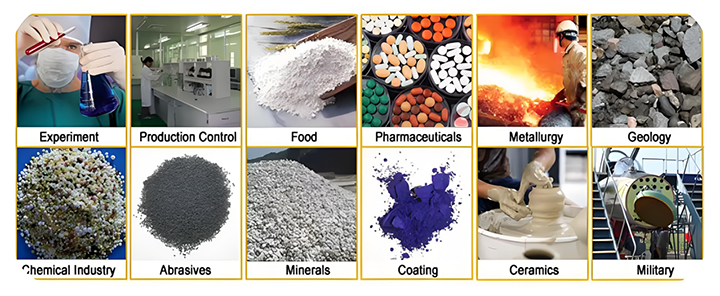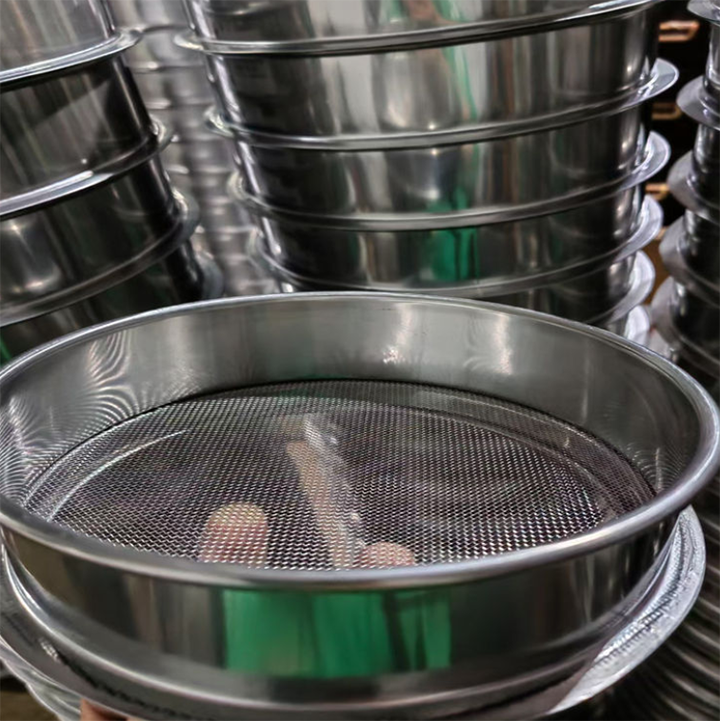Thursday October-30 2025 11:59:05
Laboratory woven wire mesh sievesuse the physical barrier effect of their mesh openings to separate mixed materials according to particle size differences, while removing impurities and obtaining particle size distribution data. The equipment can perform dry or wet sieving of fine powders, dry granules, brittle and hard powders, as well as moist and sticky materials.

Mesh sizes can range from 20 micrometers to 5 millimeters, with common specifications including 20 μm, 45 μm, 75 μm, 150 μm, 300 μm, 600 μm, 1 mm, 2 mm, and 5 mm, ensuring that particles do not pass through or clog the sieve during the sieving process. Sieving can separate excessively coarse or fine materials to obtain materials with uniform particle size.
The characteristics of laboratory woven wire mesh sieves determine their performance and application range. Firstly, regarding materials, stainless steel (such as 304 or 316) is most commonly used to ensure durability, corrosion resistance, and chemical compatibility with materials, making it particularly suitable for most general applications and those requiring rust prevention. For certain industries (such as grain processing), brass is sometimes chosen to avoid sparks or specific chemical reactions. When handling materials sensitive to metals, non-metallic screens such as nylon or polyester are used.

The mesh size and screen structure are its most crucial parameters. Mesh size strictly adheres to international standards, typically measured in micrometers or millimeters, corresponding to standard mesh counts. The screen consists of a uniform mesh of metal wires interwoven in a plain or twill pattern. Precise control of wire diameter and mesh size ensures the screen is both robust and durable, enabling high-precision particle grading and sieving.
Laboratory Woven Wire Mesh Sieves Mesh Size Chart
| U.S. MESH | MICRONS | MILLIMETERS | INCHES |
|---|---|---|---|
| 3 | 6730 | 6.730 | 0.2650 |
| 4 | 4760 | 4.760 | 0.1870 |
| 5 | 4000 | 4.000 | 0.1570 |
| 6 | 3360 | 3.360 | 0.1320 |
| 7 | 2830 | 2.830 | 0.1110 |
| 8 | 2380 | 2.380 | 0.0937 |
| 10 | 2000 | 2.000 | 0.0787 |
| 12 | 1680 | 1.680 | 0.0661 |
| 14 | 1410 | 1.410 | 0.0555 |
| 16 | 1190 | 1.190 | 0.0469 |
| 18 | 1000 | 1.000 | 0.0394 |
| 20 | 841 | 0.841 | 0.0331 |
| 25 | 707 | 0.707 | 0.0280 |
| 30 | 595 | 0.595 | 0.0232 |
| 35 | 500 | 0.500 | 0.0197 |
| 40 | 400 | 0.400 | 0.0165 |
| 45 | 354 | 0.354 | 0.0138 |
| 50 | 297 | 0.297 | 0.0117 |
| 60 | 250 | 0.250 | 0.0098 |
| 70 | 210 | 0.210 | 0.0083 |
| 80 | 177 | 0.177 | 0.0070 |
| 100 | 149 | 0.149 | 0.0059 |
| 120 | 125 | 0.125 | 0.0049 |
| 140 | 105 | 0.105 | 0.0041 |
| 170 | 88 | 0.088 | 0.0035 |
| 200 | 74 | 0.074 | 0.0029 |
| 230 | 63 | 0.063 | 0.0024 |
| 270 | 53 | 0.053 | 0.0021 |
| 325 | 44 | 0.044 | 0.0017 |
| 400 | 37 | 0.037 | 0.0015 |
Common diameters for laboratory woven wire mesh sieves include 3in (75mm), 4in (100mm), 6in (150mm), 8in (200mm), and 12in (300mm), selected according to laboratory standards and the size of the vibrating sieve. The frame material is generally stainless steel or nickel-plated steel, but aluminum alloy or other metal frames are also available to ensure the sieve is stable, corrosion-resistant, and easy to clean. The sieve aperture ranges from 20μm to 25mm, offering high precision and conforming to standards such as ASTM E11 and ISO 3310-1, accurately classifying particle sizes and ensuring reliable experimental data.
| Applications | separation, fractioning, particle size determination |
| Field of application | agriculture, biology, chemistry / plastics, construction materials, engineering / electronics, environment / recycling, food, geology / metallurgy, glass / ceramics, medicine / pharmaceuticals |
| Feed material | powders, bulk materials, suspensions |
| Frame diameter | ø 200 mm / 203 mm (8 inch) |
| Surface type | wire gauze |
| Mesh sizes | 125 mm - 20 µm |
| Standards | ISO 3310-1 / ASTM E11 |
Laboratory woven wire mesh sieves are suitable for most scenarios requiring sieving. For example, fine sieving of traditional Chinese medicine powders involves classifying them using sieves of different aperture sizes to remove lumps or ultrafine powders. The classified particles can be used for tableting, capsule filling, or further experimental analysis. Spice particles are poured into sieves and sieved by vibration or manually; large particles and impurities remain on top, while small particles are collected through the sieve openings. These particles can be used for quality control before production or experimental formulation research. Coal powder is placed in a sieve and classified by vibrating sieves or manual tapping. The weight percentage of particles of different sizes is determined for particle size analysis and process optimization.

Laboratory woven wire mesh sieves suppliers typically have mature processes, quality control, and comprehensive product lines, such as Labsieve and Endecotts. Our factory has 15 years of experience in manufacturing sieving equipment. Our products meet international standards. We can conduct trial runs with raw materials and customize sieves or laboratory sieve sets according to the target particle size. We also provide comprehensive calibration and after-sales service. This provides crucial data accuracy and result reproducibility for scientific research and quality control work such as particulate material analysis and particle size determination.

Laboratory woven wire mesh sieves are available in various diameters and aperture sizes for particle classification and analysis in laboratories such as chemical and agricultural industries. They comply with international standards such as ISO 3310-1 and ASTM E11. Customers can choose suppliers with different materials and specifications according to their needs. Prices vary depending on the material, size, and customization requirements. During daily use, attention should be paid to vibrating or manual sieving operations, and regular cleaning and maintenance are necessary to maintain the accuracy and lifespan of the sieve.
Soil sieve analysis is a soil particle size determination method based on the principle of mechanical separation...
Juice Powder Ultrasonic Sieve test
The ultrasonic sieve test for juice powder is a fine screening equipment designed for delicate, moisture-absorbing...
Standard Test Method for Particle-Size Analysis of Soils
Standard Test Method for Particle-Size Analysis of Soils (ASTM D422)aims to accurately determine the size distribution of soil particles...
Size sieve for soil primarily involves the sieve frame diameter and sieve aperture size...
Oct 30, 2025
Laboratory woven wire mesh sieves
Laboratory woven wire mesh sieves are screening tools made of 250 mm stainless steel frame and precis...
Oct 30, 2025
Sieve Mesh is a metal or non-metal device used to separate materials. Its mesh count refers to the nu...
Oct 25, 2025
For Laboratory Sieves Price ranges from $100 to $500 USD, and the price varies depending on the sieve...
Oct 22, 2025
For Laboratory Sieves Suppliers
For Laboratory Sieves Suppliers manufactures sieve frames in 3-inch, 8-inch, and 12-inch diameter siz...
![]()
Then we look forward to hearing from you
Contact Us
Industrials
Yanjin county forest park gate to the west 1000 meters north road sitemap
